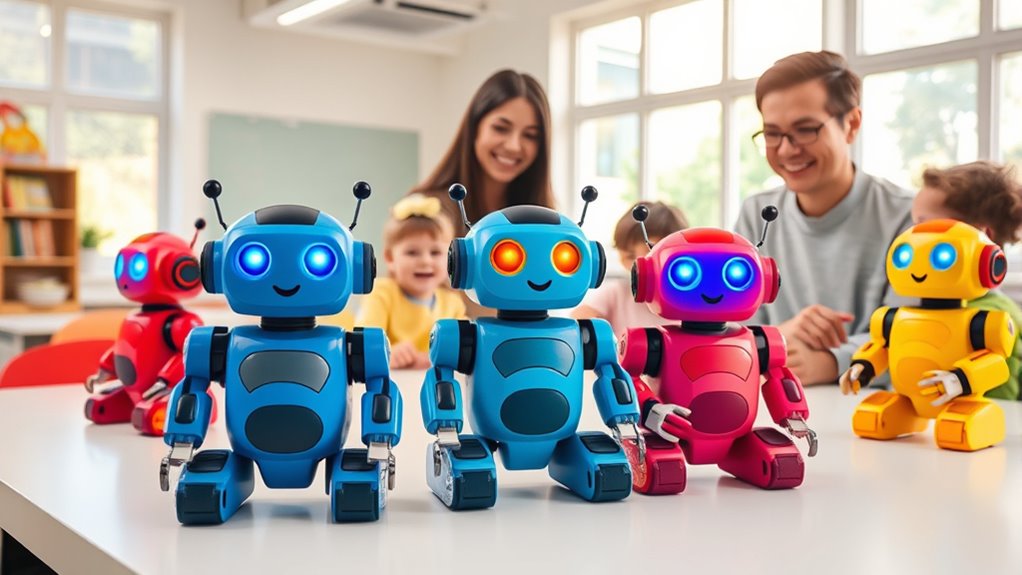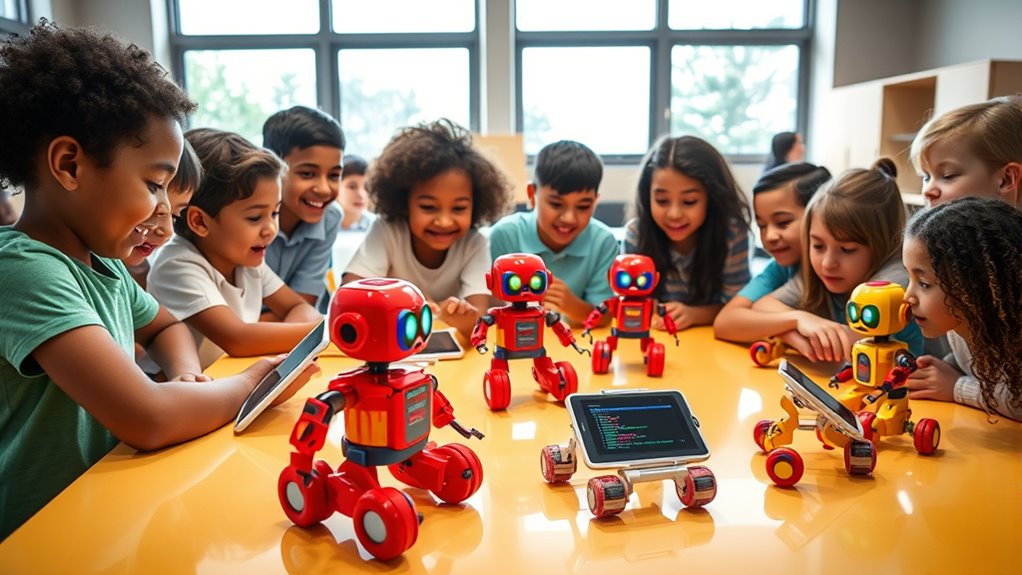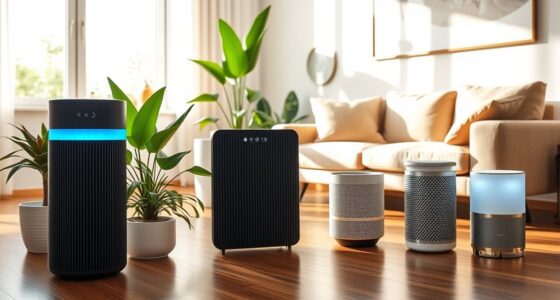I’ve explored the top coding robots for kids that make learning programming fun and simple. From easy-to-assemble kits like Botley and Dash to more advanced options such as STEM Robotics Kits and AoHu Solar Robots, there’s something for every age and skill level. These toys promote creativity, problem-solving, and STEM skills through interactive, screen-free, or app-controlled experiences. Keep going to discover the best options to spark your child’s interest in coding and engineering.
Key Takeaways
- Features like app control, multiple programming modes, and sensors make coding engaging and accessible for kids of various ages.
- Many robots offer quick setup and screen-free options, ensuring immediate fun and learning with minimal frustration.
- Durable, portable designs support hands-on activities at home or in the classroom, fostering creativity and problem-solving.
- Comprehensive educational content, including STEM lessons and coding progression, enhances skill development from beginner to advanced levels.
- User-friendly interfaces and versatile features cater to different learning styles, making coding both fun and easy for children.
Q-Scout STEM Projects for Kids
Are you looking for a fun and educational way to introduce kids to coding and robotics? Q-Scout is perfect for children aged 8-12, offering a step-by-step learning journey from drag-and-drop Scratch to Arduino and Python. It helps kids understand programming, electronics, and robotics by letting them build and play with their creations. The robot features four modes, including remote control, obstacle avoidance, music, and route following, making learning interactive and entertaining. Assembly is quick—about 30 minutes—and the open-source design encourages customization, fostering creativity and teamwork. Plus, its durable materials ensure it can handle indoor and outdoor adventures.
Best For: Kids aged 8-12 who are interested in learning coding, robotics, and electronics through hands-on building and interactive play.
Pros:
- Supports a gradual learning curve from Scratch to Python, enhancing coding skills.
- Multiple interactive modes promote engaging and versatile play experiences.
- Easy assembly with detailed instructions encourages teamwork and creativity.
Cons:
- May require adult supervision during initial setup for younger children.
- Some advanced features might need additional electronic modules or parts.
- Durability could vary depending on handling and outdoor conditions.
STEM Robotics Science Kit for Adults and Teens
The STEM Robotics Science Kit for Adults and Teens is an excellent choice for anyone aged 12 and up who wants to immerse themselves in robotics and programming. With an ESP8266 motherboard, app remote control, and six movement modes, it offers dynamic, engaging performance. The kit includes detailed lessons on electronics, coding, and hands-on skills, making it perfect for systematic learning. Assembly can be challenging, requiring patience and prior electronics experience, but it’s rewarding once completed. Designed with a durable acrylic body and metal servo, it promotes problem-solving and creativity. While some setup hurdles exist, it’s an excellent tool for teens and adults enthusiastic to explore STEM robotics.
Best For: hobbyists, teens, and adults eager to learn robotics and programming through hands-on assembly and experimentation.
Pros:
- Comprehensive lessons and tutorials support systematic learning of electronics and coding.
- Durable construction with a metal servo and acrylic body promotes stability and long-term use.
- Dynamic performance with multiple movement modes and remote app control offers engaging, vivid demonstrations.
Cons:
- Assembly can be tedious and may require prior electronics experience and patience.
- Setup may involve troubleshooting software, drivers, and battery compatibility issues.
- Batteries and some detailed instructions may need to be purchased separately, adding to the overall cost.
Game for AI Learners! NBC Featured: AI Board Game for Kids Age 6
Looking for an engaging way to introduce young children to artificial intelligence? NBC featured Coder Mindz, a unique AI board game designed for kids aged 6 and up. Created by 9-year-old Samaira, it teaches AI concepts like image recognition, training, and autonomous behavior through fun robot and neural adventure gameplay. The game also covers coding basics such as loops, functions, and conditionals, making complex topics accessible. With multiple difficulty levels and modes, it grows with the child’s skills. Easy to set up and play, Coder Mindz offers a hands-on, educational experience that fosters strategic thinking, problem-solving, and AI understanding—perfect for home, school, or coding clubs.
Best For: young children aged 6 and above, educators, and parents seeking an engaging, educational introduction to AI and coding fundamentals.
Pros:
- Simplifies complex AI and coding concepts for early learners through fun gameplay.
- Offers multiple difficulty levels and modes to grow with the child’s skills.
- Supports classroom, home, and extracurricular learning with a free downloadable curriculum.
Cons:
- Some minor technical errors in game cards may require clarification or updates.
- May need adult supervision or guidance for younger children to maximize learning.
- Limited digital interaction, relying on physical components, which might reduce engagement for tech-savvy kids.
AoHu 15-in-1 STEM Solar Robot Toys for Kids
For parents and educators seeking a hands-on STEM experience, the AoHu 15-in-1 STEM Solar Robot Toys stand out as an engaging choice. This kit offers 212 durable plastic pieces to build 15 different models, including land and water explorers. Powered by solar energy and a battery (not included), kids can experiment with renewable energy and motion concepts. The assembly process promotes engineering skills and problem-solving, fostering creativity and curiosity. While some parts can be tricky to connect and assembly may be challenging, the educational value and fun of building real working robots make this a rewarding, screen-free activity for children aged 8-12.
Best For: parents, educators, and children aged 8-12 interested in hands-on STEM learning, robotics, and eco-friendly experiments.
Pros:
- Promotes STEM education through engaging, hands-on assembly of 15 different robot models
- Encourages creativity, problem-solving, and scientific curiosity with solar and battery power options
- Supports family bonding and screen-free fun in a durable, age-appropriate kit
Cons:
- Assembly can be challenging due to tiny, fragile parts and sometimes poor-fitting connectors
- Some users report difficulties with the solar panels and moving parts not functioning properly
- Customer service responses may be slow or unresponsive for certain product issues
Learning Resources Botley Coding Robot STEM Toy (45 Piece Set)
If you’re searching for an engaging way to introduce young children to coding, the Learning Resources Botley Coding Robot STEM Toy (45 Piece Set) stands out as an excellent choice. Designed for kids ages 5 and up, it promotes early coding, problem-solving, and critical thinking through screen-free play. With features like obstacle avoidance, object detection, looping commands, and black-line following, Botley offers diverse challenges. It’s ready out of the box, uses coding cards and a remote, and includes fun accessories for obstacle courses. Compact and lightweight, it’s perfect for hands-on learning, making coding accessible and entertaining for young learners.
Best For: young children ages 5 and up who are beginning to explore coding concepts through hands-on, screen-free play to develop problem-solving and critical thinking skills.
Pros:
- Easy to set up and start using right out of the box with included coding cards and remote.
- Promotes STEM skills through interactive, screen-free activities like obstacle courses and line following.
- Engages children with fun sounds, secret commands, and expandable challenges to grow with their skills.
Cons:
- High battery consumption requiring frequent replacements of AAA batteries.
- Limited maze size and finicky obstacle detection, especially on carpets, restrict continuous play.
- Small play areas and the need for precise setup may be challenging for multiple children to share simultaneously.
Dash Robot – Coding Robots for Kids 6
The Dash Robot is an excellent choice for children aged 6 and older who are just beginning to explore coding and robotics. It’s an interactive, voice-activated STEM toy that requires no assembly, so kids can start learning right away. Dash can sing, dance, navigate obstacles, respond to voice commands, and be programmed through multiple user-friendly apps. With accessories like building brick connectors and a USB charger, it offers up to 5 hours of play. Its durable design, increased memory, and smooth motors make it ideal for classroom, family, or individual use. Dash’s engaging activities introduce essential coding concepts while fostering creativity and problem-solving skills.
Best For: children aged 6 and older who are new to coding and robotics, seeking an engaging, easy-to-use STEM toy that promotes creativity and problem-solving.
Pros:
- User-friendly, voice-activated interface suitable for beginners
- No assembly required, allowing immediate start to learning and play
- Durable design with long battery life and versatile educational features
Cons:
- Lack of a user manual or quick start guide for first-time setup
- Limited code export or viewing options for comparing programmed commands
- Variability in battery charging and longevity issues reported by some users
Sphero Mini (Blue) Coding Robot Ball for Kids and Teens
Kids and teens interested in exploring robotics and coding will find the Sphero Mini (Blue) an excellent starting point because it combines a compact design with impressive programming features. About the size of a ping pong ball, it’s durable and fun to control via Bluetooth using the free Sphero Edu app. You can program it with drawing, drag-and-drop blocks, or JavaScript, making it perfect for beginners and advanced users alike. With modes like golf and obstacle courses, plus accessories like traffic cones, it encourages creative play and STEAM learning. Its versatility, combined with a manageable size and engaging features, makes it an ideal robot for budding coders.
Best For: beginners and intermediate kids, teens, and educators interested in exploring robotics, coding, and STEAM activities through a fun, compact, programmable robot ball.
Pros:
- Compact, durable design perfect for small hands and portable play
- Supports multiple programming methods including drawing, block coding, and JavaScript for versatile learning
- Engaging features like obstacle courses and accessories promote creative and interactive play
Cons:
- Limited control accuracy and some modes can be tricky to master
- Bluetooth disconnections and orientation drift may affect user experience
- Short battery life of around 1 hour with a 1-hour recharge time
Makeblock mBot Robot Kit for Kids Ages 8-12 STEM Coding and Robotics Toys
For children aged 8 to 12 interested in exploring robotics and coding, the Makeblock mBot Robot Kit offers an engaging and straightforward introduction to STEM concepts. It’s easy to assemble in about 15 minutes, thanks to clear instructions and durable parts. The kit is compatible with over 100 electronic modules and LEGO pieces, allowing for versatile configurations. Kids can program the robot using free apps and software that support both beginner-friendly Scratch and more advanced C++ coding. With features like obstacle avoidance and line-following, the mBot makes learning fun while developing problem-solving skills. It’s a perfect gift for fostering creativity and STEM learning.
Best For: children aged 8-12 who are interested in learning robotics and coding through a fun, easy-to-assemble STEM kit.
Pros:
- User-friendly assembly with clear instructions suitable for beginners
- Highly versatile, compatible with over 100 modules and LEGO pieces for extensive customization
- Supports multiple programming levels from Scratch to C++, fostering progressive learning
Cons:
- Batteries for remote control and robot are sold separately, adding to overall cost
- Slightly higher price point, though often reduced during sales
- Occasional reports of missing parts or software bugs, requiring customer support assistance
ELEGOO UNO R3 Robot Car Kit V4 for Arduino STEM Kids 8-16
Designed specifically for beginners aged 8 to 16, the ELEGOO UNO R3 Robot Car Kit V4 offers an engaging way to learn programming and robotics through hands-on building. It includes 24 modules like obstacle avoidance, line tracing, and infrared remote control, compatible with Android and iOS devices. The kit features motors, sensors, a camera, and a servo, all easily assembled via standardized ports. It comes with detailed HD tutorials and pre-loaded programs for quick setup. While some users encounter issues like high speed or WiFi connectivity, these can often be resolved with firmware updates or adjustments, making it a versatile choice for young learners.
Best For: beginners aged 8 to 16 who want to learn programming and robotics through hands-on building and experimentation.
Pros:
- Includes a comprehensive set of modules like obstacle avoidance, line tracing, and remote control for versatile learning.
- Comes with detailed HD tutorials and pre-loaded programs enabling quick assembly and operation.
- Compatible with Android and iOS devices, allowing remote control and customization options.
Cons:
- Small parts require manual dexterity and patience during assembly.
- High speed may cause stability issues like wheelies, needing firmware adjustments.
- WiFi connectivity can be weak depending on environment, and some programming compatibility issues may arise with IDE updates.
Learning Resources Code & Go Robot Mouse Activity Set
Are you searching for a hands-on way to introduce young children to coding and problem-solving? The Learning Resources Code & Go Robot Mouse Activity Set is perfect for kids aged 4 and up. It includes a programmable mouse, maze tiles, walls, tunnels, and coding cards, encouraging creativity and critical thinking. Kids build mazes and program the mouse to navigate obstacles using color-coded buttons, learning sequencing and algorithms along the way. The set’s durability and engaging challenges make it ideal for both classroom and home use. It’s a fun, screen-free introduction to STEM concepts that helps kids develop logical reasoning and spatial skills while having a blast.
Best For: young children aged 4 and up who are beginning to explore coding, problem-solving, and STEM skills in a hands-on, screen-free environment.
Pros:
- Encourages creativity, critical thinking, and problem-solving through maze building and programming.
- Durable, easy-to-use design with color-coded buttons simplifies early coding concepts.
- Suitable for both classroom and home use, promoting family engagement and extended play.
Cons:
- Requires 3 AAA batteries (not included), adding an extra purchase step.
- Occasionally the mouse may not execute turns or commands perfectly, which might cause some frustration.
- Assembly can be challenging for younger children without adult assistance.
Learning Resources Cooper The STEM Robot Classroom Set
If you’re looking for an engaging way to introduce young learners to coding without screens, the Learning Resources Cooper The STEM Robot Classroom Set stands out. Designed for kids ages 5-16, it offers hands-on activities that build critical thinking, problem-solving, and logical skills. Cooper features interactive modes like line tracking, light sensing, obstacle avoidance, and robot-to-robot communication, making learning dynamic. The kit includes lesson cards, coding cards, accessories, and online content, perfect for classroom or home use. Its durable design, rechargeable battery, and engaging features keep kids motivated and exploring programming concepts in a fun, accessible way.
Best For: educators, parents, and homeschoolers seeking a screen-free, engaging STEM learning tool for children aged 5-16 to develop coding, problem-solving, and critical thinking skills through hands-on activities.
Pros:
- Encourages critical thinking, problem-solving, and creativity in young learners
- Durable, easy-to-use design with multiple interactive modes for varied activities
- Includes comprehensive lesson plans, coding cards, and online resources for immediate classroom or home use
Cons:
- Older children may require guidance to fully explore all functionalities
- Limited digital interaction may not appeal to children seeking screen-based tech experiences
- Some activities may take longer than expected, requiring additional time management
5-in-1 STEM Robot Building Kit with App & Remote Control
The in-1 STEM Robot Building Kit with App & Remote Control is an excellent choice for children aged 6 to 12 who enjoy hands-on learning and creative problem-solving. With 620 pieces, it lets kids build five different robots, like Super Warriors and Battle Dog, encouraging engineering and coding skills. Its dynamic LED eyes and remote control add emotional expression and interactivity. The kit features high-speed motors, rechargeable batteries, and app control with 360° movement, making play engaging and precise. Though assembly can take time and be challenging for younger children, the kit offers great value, fostering creativity, patience, and early STEM learning in a fun, versatile package.
Best For: children aged 6 to 12 who enjoy hands-on STEM activities, creative building, and interactive robotic play.
Pros:
- Offers multiple building options with 620 pieces to encourage creativity and engineering skills.
- Includes app and remote control for precise, interactive play with dynamic LED eyes for emotional expression.
- Promotes early coding and problem-solving skills through engaging, educational activities.
Cons:
- Assembly can be time-consuming and complex, especially for younger children, requiring adult supervision.
- Small parts and intricate connections may pose a choking hazard and challenge for some kids.
- Limited movement functionality and cosmetic focus may lead to some disappointment in performance.
KEYESTUDIO Smart Car Robot 4WD Programmable DIY Kit for Arduino
The KEYESTUDIO Smart Car Robot 4WD Programmable DIY Kit is an excellent choice for teens and adults interested in hands-on STEM learning, especially those enthusiastic to explore electronics and coding. It includes mechanical parts, sensors like IR, Sonic, Bluetooth, and a dot matrix display, plus tools and a manual for assembly and programming. The kit supports multiple modes, including obstacle avoidance and line tracking, making it great for in-depth learning. While assembly can be challenging and software setup may cause issues, the detailed tutorials and support help users troubleshoot. Overall, it’s a durable, educational robot that encourages problem-solving and coding skills.
Best For: hobbyists, teens, and adults interested in STEM education, electronics, and coding who want to build and program their own 4WD robot.
Pros:
- Comprehensive kit with mechanical parts, sensors, tools, and detailed tutorials for easy learning.
- Supports multiple operation modes such as obstacle avoidance, line tracking, and remote control.
- Durable construction and positive feedback on educational value and hands-on experience.
Cons:
- Assembly can be challenging, especially for beginners unfamiliar with electronics and mechanical assembly.
- Software setup and Bluetooth connectivity may face compatibility issues, causing frustration.
- Higher price point and some users report difficulties with operation due to hardware or software problems.
Robot Toys for Kids with Gesture Sensing & LED Eyes, Star Projector & Music
Kids who love interactive and magical play will find this robot toy especially enchanting, thanks to its gesture sensing and star projection features. With flashing LED eyes, glowing tank treads, and a nodding head, it captures kids’ attention instantly. The star projector displays colorful stars and a gentle moon, paired with soothing melodies to help children feel safe and relaxed. Its smart gesture control makes play intuitive—simply wave your hand to make it move or rotate. Crafted from safe, durable materials, this robot is perfect for kids aged 3-12. It provides hours of engaging, imaginative fun while inspiring curiosity and dreams during playtime or bedtime.
Best For: children aged 3-12 who enjoy interactive, magical, and imaginative play with engaging lights, sounds, and movement.
Pros:
- Captivates children with flashing LED eyes, star projection, and movement; enhances sensory and imaginative development.
- Easy to operate with smart gesture control, making play intuitive and engaging.
- Made from safe, durable ABS material suitable for active children and long-lasting use.
Cons:
- Some users have reported issues with the build quality of the controller.
- Requires USB charging, which may be less convenient than battery-only toys.
- The size and weight may be less portable for on-the-go play outside the home.
Evo Entry Kit: Interactive Coding Robot for Kids
If you’re looking for an engaging way to introduce children to coding, the Evo Entry Kit by Ozobot is an excellent choice because it combines hands-on play with educational depth. The kit includes a durable Evo robot, color code markers, a charging cable, and a hard shell case, plus access to over 700 STEM lessons. It supports both online coding through Ozobot Blockly and screen-free learning with color codes, making it adaptable for all learning styles. Suitable for beginners and growing with your child’s skills, this kit offers a user-friendly way to develop critical thinking, problem-solving, and creativity in a fun, classroom-ready package.
Best For: educators, parents, and kids of all ages seeking an engaging, versatile introduction to coding and robotics in both classroom and home settings.
Pros:
- Supports both online Blockly coding and screen-free color code learning for flexible education.
- Includes over 700 free STEM lessons that grow with the child’s skill level.
- Durable, classroom-ready components with portable storage for easy organization.
Cons:
- Requires initial setup and familiarization, which may take some time for absolute beginners.
- May need additional accessories or updates for advanced features over time.
- The physical markers and robot, while durable, can be lost or damaged if not handled carefully.
Factors to Consider When Choosing Coding Robots for Kids

When choosing coding robots for kids, I always consider their age and skill level to make sure the robot is both engaging and challenging. I also look at how easy it is to assemble and program, since frustration can hinder learning. Finally, I check the robot’s durability and materials to make sure it can withstand active play.
Age Appropriateness
Choosing the right coding robot depends heavily on the child’s age and developmental stage. It’s essential to select a robot with a recommended age range that matches your child’s abilities to guarantee effective learning and engagement. For younger children (ages 4-7), look for robots with simple interfaces like drag-and-drop or color-based coding, which are easier to grasp. Older kids (ages 8-12 and above) can handle more complex programming languages such as Python or Arduino, offering more advanced problem-solving opportunities. Also, consider whether features like gesture control or voice activation are suitable and safe for their age group. Picking age-appropriate hardware and software helps prevent frustration and keeps their interest in STEM learning alive.
Skill Level Compatibility
Selecting a coding robot that matches a child’s skill level guarantees they stay motivated and can learn effectively. I recommend checking if the robot’s programming interface suits their experience—drag-and-drop blocks for beginners or text-based coding for more advanced learners. It’s also helpful if the robot offers progressive learning features that let kids gradually tackle more complex tasks. Make sure the included lessons or tutorials are age-appropriate and match their current skills to avoid frustration. Additionally, verify that the robot’s setup and assembly are suitable for their technical abilities, preventing boredom or confusion. Ultimately, consider whether it aligns with educational standards or curricula, ensuring continuous skill development and a smooth learning path as they grow.
Ease of Assembly
Ease of assembly plays a crucial role in how enjoyable and accessible a coding robot is for kids. If the robot has snap-together pieces or requires minimal tools, it’s much more suitable for younger children or beginners. Clear, step-by-step instructions or visual guides help make the building process straightforward and reduce frustration. I also consider the durability and ease of handling parts, as fragile or complicated pieces can cause breakage or discourage kids from tinkering. Fewer parts generally mean quicker, less intimidating assembly, which keeps kids engaged and motivated. Additionally, a design that allows for easy disassembly and reconfiguration encourages ongoing exploration and learning. Overall, simple, well-designed assembly features make the experience fun and encourage kids to take ownership of their robotic projects.
Programming Complexity
The complexity of a robot’s programming interface plays a essential role in how easily kids can learn and enjoy coding. Simpler robots with drag-and-drop, graphical block coding are perfect for beginners and young children, requiring minimal prior knowledge. They make learning fun and accessible, especially with guided tutorials and step-by-step instructions that ease the process. As kids grow more confident, more advanced robots support text-based programming languages like Python or C++, offering a steeper learning curve but enabling deeper skill development. Many models allow for increasing levels of complexity, helping children develop problem-solving and computational thinking gradually. Choosing the right balance of programming complexity ensures kids stay challenged without feeling overwhelmed, fostering a positive and engaging learning experience.
Durability and Materials
Because kids tend to be energetic and curious, choosing a coding robot with durable materials is essential. High-quality plastics like ABS or polycarbonate are common choices, as they resist drops, collisions, and rough play. Reinforced joints, thicker chassis, and sturdy wheels or treads help guarantee the robot can handle active learning environments without breaking down. It’s also important that electronic modules and sensors are securely embedded and protected with waterproof or dustproof casings, preventing damage from environmental factors. A well-constructed robot balances lightweight portability with strength, making it safe and reliable for long-term use. When selecting a robot, pay attention to its materials and build quality to ensure it can withstand the inevitable bumps and tumbles of a kid’s adventurous exploration.
Educational Content
Choosing a coding robot that offers rich educational content can make a significant difference in a child’s learning experience. I look for kits that feature a thorough curriculum, starting with basic concepts and advancing gradually to more complex topics, ensuring sustained growth. Access to online tutorials, coding challenges, and resources tailored to different ages and skill levels is essential for keeping kids engaged and progressing. The content should cover core STEM principles like algorithms, loops, conditionals, and problem-solving, laying a strong foundation. I also prioritize robots that demonstrate real-world applications, such as robotics, automation, or AI, to make coding feel relevant and practical. Finally, flexible educational content allows for use in various settings—classroom, homeschool, or independent learning—maximizing versatility.
Connectivity Options
When selecting a coding robot for kids, considering its connectivity options is essential for guaranteeing seamless interaction and flexibility. Robots connect via Bluetooth, Wi-Fi, USB, or proprietary wireless systems, each offering different benefits. Bluetooth robots usually have about a 30-foot range, perfect for indoor use and small groups. Wi-Fi-enabled robots allow for remote control and programming over larger distances, making them great for classrooms or home setups. USB connections provide a stable, direct link for programming and charging but limit mobility. Some robots support multiple connectivity options, giving you the flexibility to switch between wireless and wired modes depending on activity needs. Choosing the right connectivity ensures smooth operation and enhances the learning experience without unnecessary interruptions.
Price and Value
Selecting a coding robot for kids requires careful consideration of its price relative to the features and durability it offers. I always check if the cost matches the educational value, including the complexity of lessons, accessories, and build quality. It’s smart to see if the robot offers progressive learning levels or expandable features, which can justify a higher price by providing long-term engagement. Comparing prices with similar products helps ensure you’re getting good value for money. Don’t forget to factor in extra costs like batteries, software, or additional accessories needed to maximize the robot’s potential. Reading reviews or ratings can also give insight into whether users feel the price reflects the quality and educational impact. A well-priced robot offers both fun and meaningful learning without breaking the bank.
Frequently Asked Questions
How Do Coding Robots Support Different Age Groups’ Learning Styles?
You’re asking how coding robots support different age groups’ learning styles, right? I find that these robots adapt well because they offer visual, hands-on activities for younger kids and more complex, problem-solving tasks for older students. They engage learners through interactive play, catering to various preferences. This versatility makes coding more accessible and fun, helping kids develop essential skills at their own pace while keeping them motivated.
What Safety Features Are Common in Coding Robots for Kids?
The safety features in coding robots for kids are truly impressive, almost like having a security team in a tiny package. Most include durable, non-toxic materials to prevent injuries, along with rounded edges to avoid cuts. Many also have automatic shut-off functions if they detect obstacles or mishandling. These features guarantee kids learn and play confidently, making coding education safe, fun, and worry-free.
Can Coding Robots Be Used for Remote or Online Learning Environments?
Absolutely, coding robots can be used for remote or online learning. I’ve seen many options that connect via Wi-Fi or Bluetooth, allowing kids to program them from home or in virtual classrooms. These robots often come with apps or web-based platforms, making it easy for students to practice coding skills remotely. It’s a great way to keep learning interactive and fun, even when physically apart.
How Do Coding Robots Foster Creativity Alongside Technical Skills?
Think of coding robots as tiny artists and engineers rolled into one. They ignite kids’ creativity by encouraging them to invent, design, and customize their projects. As kids experiment and troubleshoot, they develop critical thinking skills that blend seamlessly with technical know-how. These robots turn abstract coding concepts into tangible adventures, making learning an exciting journey where imagination fuels innovation and technical mastery grows side by side.
What Are the Long-Term Educational Benefits of Using Coding Robots?
Exploring the long-term educational benefits of coding robots, I see they boost problem-solving, critical thinking, and perseverance. Kids learn to debug, experiment, and innovate, skills essential for future careers. These robots also foster confidence and a growth mindset, encouraging continuous learning. Over time, children develop a strong foundation in STEM, making them better prepared for technological advancements and diverse opportunities in an increasingly digital world.
Conclusion
Picking the right coding robot is like choosing the perfect puzzle piece—you want one that fits your child’s interests and sparks their curiosity. These robots turn learning into an adventure, making coding feel like a game rather than a chore. Whether they’re building, programming, or exploring, each of these options offers a fun way to develop skills. Give your kid the tools to thrive and watch their confidence grow like a blossoming flower.


























